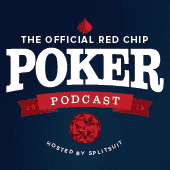Welcome to the first episode of The Official Red Chip Poker Podcast! We start this podcast by exploring a crossroads that all TAG players eventually face: how to play a looser style. How to break away from our nitty upbringing, our boring TAG ranges, and expand into LAG.
This, of course, is NOT meant for players that are newer to poker. This is for players who have an established skillset and are looking for new ways to make money at the table. If you are still improving your play with hands like AJ, small pocket pairs that miss the flop, and drawing with suited connectors, save this podcast for later in your poker journey.

Why do we want to play looser?
- Utilize your edge: If we are much stronger than our opponents, wouldn’t we want to add more hands into our ranges? We don’t need to go nuts and start opening 73s from EP, but if we could play ATs profitably, could we also play ATo and A9s?
- Take advantage of certain tables: Loosen up on tables where players are folding way too much (either preflop or postflop). On looser, spewy, tables, be very aware of things like shallow vs deep stacks and reverse implied odds.
- Improve faster: By playing looser you will encounter more situations and get accustomed to making profit out of a wider range. You won’t improve very quickly by just playing a normal ABC range, but when you are seeing many more flops, 3-betting more often, and contending for more pots, you have no choice but to improve quickly.
In this section we mentioned the Aggression In Live Games video by SplitSuit & Soto (grab a PRO Membership to watch that video and lots more!)
How do we add more hands?
- Position first: Start by looking to add hands on the button, then the cutoff, and onwards. This will keep you adding hands slowly and in the right spots.
- Normal range, fringe range, wider range: Fringe hands are just outside of your normal range. Focus on adding these hands into your ranges first. Once you get comfortable with those hands, then expand to a further fringe. And rinse/repeat until you find the point where your range is simply too wide.
- Open wider: Start here. Where can you open wider? If this is the right spot to raise wider, how wide could you go? Think ahead, and see if the spot is right.
- 3-bet more often: Look for spots where you can 3-bet wider. Hammer on players who fold too often when you 3-bet. Against spewy players, could you 3-bet a wider value range and include hands like TT, 99, AQ, etc.?
- Be solid postflop: You will go postflop more often as you add more hands into your preflop ranges. So you need to expand your abilities when it comes to flop play in 3-bet pots, playing HU pots OOP, and double barreling.
- Grab your shovel: Learn how to dig yourself out of bad situations. As you get looser, you will find yourself in a ton of awkward spots that you are unfamiliar with. Embrace this feeling and understand that you are growing as a poker player each time you do this.
An exercise I suggest for online players looking to learn how to dig themselves out of bad spots is to move down to the smallest possible stake and play 100% of hands. The point isn’t to make money; the point is to expand your poker brain, experience some new spots, and increase your skills with your shovel. Once you can dig yourself out, there is nothing to fear.
This episode was heavily influenced by our popular post: How To Play More Hands Preflop
Thanks for Listening!
Thank you for checking out our podcast. If you have any feedback or questions, just leave a comment below.
Also, we’d love if you left an honest review of the Red Chip Poker Podcast on iTunes! Ratings and reviews help more people find the show, and help us create the content you want to hear on a weekly basis.
Thanks again for hanging out with us today, and we’ll see you back soon for another conversation!


Loved the podcast. I am not as accomplished as SplitSuit, so I want to know why my tactic is wrong. After my base range I try to add hands where the situation is favorable. Instead of adding “fringe hands” like Splitsuit advocates I add hands like 87s A4s and J9s (yes these are part of late postition ranges). My goal is to make my range less predictable and to be able to represent hitting more flops. Why is it better to have a pair of Aces or Kings with a week kicker (9 or 8), when the only thing the opponent is worried about is: I got a 10 kicker, is this one of the times he shows up with a 9 or does his preflop raise mean he has a J/Q. Instead I want my opponent to worry: He usually has a J or better kicker if he has the Ace in that position, but he also showed up with 87 last time. 98 would make a straight this time, does he have air maybe? Did he miss? Or am I crushed to the straight?
Is it your experiense that people don’t think as deeply as this? Am I better off sticking to a “fringe hand expansion” or does my “separate group expansion” have some merit? I play live $1/2, most people have 50-75 BB stacks. Am I outsmarting myself, or am I just wrong?
Thanks for listening and for the great comment! A couple notes: 1.) The shorter the stacks are, the more card value is important (so A9 > 52). 2.) If a super-great spot presents itself, take it (regardless of your cards)…but recognize that your range will be super wide there and eventually people will fold less often to you in that exact spot which then pushes more value into having better-performing cards when stacks aren’t super deep. 3.) By using fringe hands we keep our ranges from going from 20% to 90%, rather our range may go from 20% to 25%. So it’s incremental, difficult for our opponents to spot, and allows us to ease into playing more hands. That alone is quite useful for most players who don’t have fully-developed shovels ♥
Glad you are making this podcast.
I have given a lot of thought about when to three-bet light and wrestled with the idea of whether it was better to do it vs. loose players, who had a wide range with a lot of bad hands, or tight players. Loose players have a lot of garbage in their opening raise range, but they hardly ever fold pre, whereas the tight players fold a lot but are more likely to have a good hand and reraise.
But I finally concluded that I was asking the wrong question. The real important thing to ask is this: will the opponent ever fourbet me light? If not, I really have nothing to fear as I will always know where I stand and never have to worry about being exploited. So the issue of loose or tight didn’t matter, just whether they would ever fight back.
Make any sense?
Thanks George!
You are on the right track. Ask youself how will they continue (them flatting is MUCH better than them 4betting overall) and what your edge is going postflop. Just because a player doesn’t fold much preflop doesn’t mean they won’t go away easily when they miss flops…
Any chance of these podcasts coming to youtube? Would love to download them to listen in my car, but really don’t want to sign up to iTunes.
Hey Steven. They likely won’t go on YouTube in their current form, but you can DL them directly from here if you’d like: https://redchippoker.libsyn.com/
Enjoy!
Perfect 😀 Thanks. PS- Picked up a copy of your new book earlier today. Looking forward to reading it.
Enjoy it when you get it Steven!
Great Listen! Really liked the surfer/ocean analogy. Made perfect sense. Thanks!
Thanks Juan!
How would you recommend to ‘study post flop’ as mentioned towards the end of this podcast? Do you have any probability charts or situation probability sources that you like to reference?
More just that you do a lot of review/analysis of the hands you play. Also, videos and the forum are great resources for working on your postflop game =)
VERY interesting exercise suggested by James. I can remember being put in some very tough spots by players that played with a very high VPIP. Not quite every hand but sure felt like it. This exercise was like looking through another poker players eyes.
Anything that forces us out of our comfort zone and expands our thought process is a snap-win as far as I’m concerned =)
Interesting exercise! Very informative episode. I was curious if you think this exercise would be relevant in SNG’s. I would think it isn’t as post-flop play becomes are lot more less relevant in the later stages of the SNG, as well as there isn’t an ability to reload like there would be in Cash games. I’m more of an STT player, so I’m assuming I just have to keep listening to episodes before I find advice that might be more relevant. But maybe I’m wrong of course, and this is more relevant to SNG’s and MTT’s than I would imagine.
Excellent! All of this content is very relevant and useful at the table. I especially liked the “ocean analogy”. Adjust to the table. Negreanu says, “be a chameleon.” Going along with this, it is VERY important to have some knowledge of the players to your immediate left. If they are tough, aggro, sticky players… you need to think ahead. Have a plan as James said. If you’re starting to think about isolating the weak player to your right, believe me, the tough player to your left will start squeezing you. Doesn’t mean you can’t play, just have a plan.
Good luck. Have fun!
Cheers Albert!